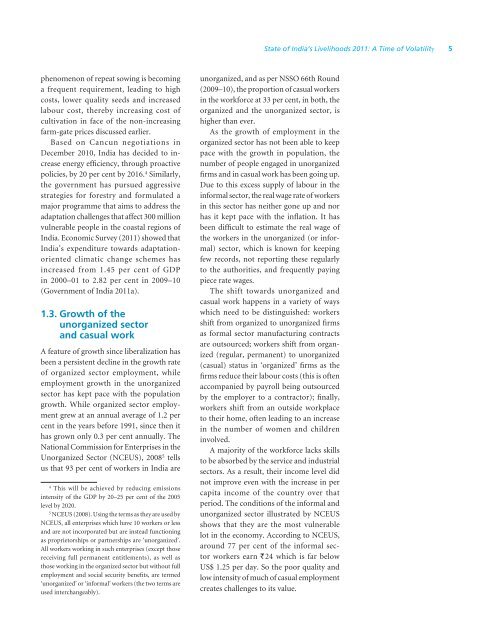SOIL Report 2011 - ACCESS Development Services
SOIL Report 2011 - ACCESS Development Services
SOIL Report 2011 - ACCESS Development Services
- No tags were found...
Create successful ePaper yourself
Turn your PDF publications into a flip-book with our unique Google optimized e-Paper software.
State of India’s Livelihoods <strong>2011</strong>: A Time of Volatility 5phenomenon of repeat sowing is becominga frequent requirement, leading to highcosts, lower quality seeds and increasedlabour cost, thereby increasing cost ofcultivation in face of the non-increasingfarm-gate prices discussed earlier.Based on Cancun negotiations inDecember 2010, India has decided to increaseenergy efficiency, through proactivepolicies, by 20 per cent by 2016. 4 Similarly,the government has pursued aggressivestrategies for forestry and formulated amajor programme that aims to address theadaptation challenges that affect 300 millionvulnerable people in the coastal regions ofIndia. Economic Survey (<strong>2011</strong>) showed thatIndia’s expenditure towards adaptationorientedclimatic change schemes hasincreased from 1.45 per cent of GDPin 2000–01 to 2.82 per cent in 2009–10(Government of India <strong>2011</strong>a).1.3. Growth of theunorganized sectorand casual workA feature of growth since liberalization hasbeen a persistent decline in the growth rateof organized sector employment, whileemployment growth in the unorganizedsector has kept pace with the populationgrowth. While organized sector employmentgrew at an annual average of 1.2 percent in the years before 1991, since then ithas grown only 0.3 per cent annually. TheNational Commission for Enterprises in theUnorganized Sector (NCEUS), 2008 5 tellsus that 93 per cent of workers in India are4This will be achieved by reducing emissionsintensity of the GDP by 20–25 per cent of the 2005level by 2020.5NCEUS (2008). Using the terms as they are used byNCEUS, all enterprises which have 10 workers or lessand are not incorporated but are instead functioningas proprietorships or partnerships are ‘unorganized’.All workers working in such enterprises (except thosereceiving full permanent entitlements), as well asthose working in the organized sector but without fullemployment and social security benefits, are termed‘unorganized’ or ‘informal’ workers (the two terms areused interchangeably).unorganized, and as per NSSO 66th Round(2009–10), the proportion of casual workersin the workforce at 33 per cent, in both, theorganized and the unorganized sector, ishigher than ever.As the growth of employment in theorganized sector has not been able to keeppace with the growth in population, thenumber of people engaged in unorganizedfirms and in casual work has been going up.Due to this excess supply of labour in theinformal sector, the real wage rate of workersin this sector has neither gone up and norhas it kept pace with the inflation. It hasbeen difficult to estimate the real wage ofthe workers in the unorganized (or informal)sector, which is known for keepingfew records, not reporting these regularlyto the authorities, and frequently payingpiece rate wages.The shift towards unorganized andcasual work happens in a variety of wayswhich need to be distinguished: workersshift from organized to unorganized firmsas formal sector manufacturing contractsare outsourced; workers shift from organized(regular, permanent) to unorganized(casual) status in ‘organized’ firms as thefirms reduce their labour costs (this is oftenaccompanied by payroll being outsourcedby the employer to a contractor); finally,workers shift from an outside workplaceto their home, often leading to an increasein the number of women and childreninvolved.A majority of the workforce lacks skillsto be absorbed by the service and industrialsectors. As a result, their income level didnot improve even with the increase in percapita income of the country over thatperiod. The conditions of the informal andunorganized sector illustrated by NCEUSshows that they are the most vulnerablelot in the economy. According to NCEUS,around 77 per cent of the informal sectorworkers earn `24 which is far belowUS$ 1.25 per day. So the poor quality andlow intensity of much of casual employmentcreates challenges to its value.














